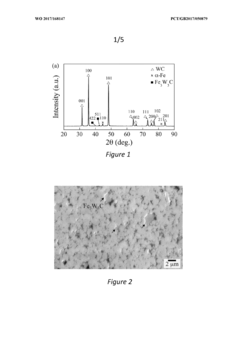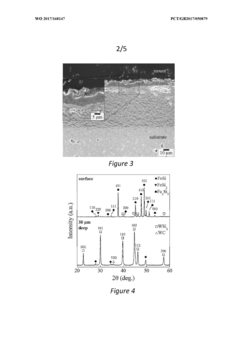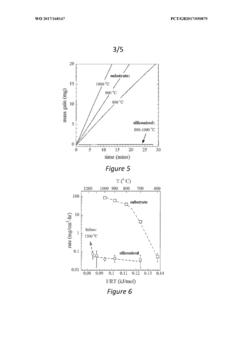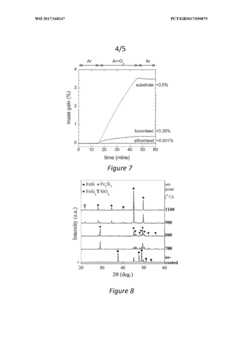How To Develop Advanced Tungsten-Based Coatings?
Tungsten Coating Evolution
Tungsten-based coatings have undergone significant evolution since their inception, driven by the increasing demands for high-performance materials in various industries. The journey of tungsten coating development can be traced back to the early 20th century when the unique properties of tungsten, such as its high melting point and excellent wear resistance, were first recognized.
In the 1950s and 1960s, the focus was primarily on developing basic tungsten coatings for industrial applications. These early coatings were predominantly pure tungsten or simple tungsten alloys, applied through rudimentary techniques such as flame spraying or plasma spraying. While these methods provided some level of protection, they often resulted in coatings with limited adhesion and relatively high porosity.
The 1970s and 1980s saw a significant leap forward with the introduction of chemical vapor deposition (CVD) techniques for tungsten coatings. This method allowed for the creation of denser, more uniform coatings with improved adhesion to the substrate. During this period, researchers also began experimenting with tungsten carbide coatings, which offered enhanced hardness and wear resistance compared to pure tungsten coatings.
The 1990s marked the beginning of a new era in tungsten coating technology with the advent of physical vapor deposition (PVD) methods, particularly magnetron sputtering. This technique enabled the deposition of ultra-thin, highly adherent tungsten coatings with precise control over composition and microstructure. Concurrently, the development of nanostructured tungsten coatings began, promising even greater improvements in mechanical and thermal properties.
The turn of the millennium brought about a focus on multi-component and multi-layered tungsten-based coatings. Researchers started combining tungsten with other elements such as titanium, chromium, and molybdenum to create coatings with tailored properties for specific applications. The concept of graded coatings, where the composition changes gradually from the substrate to the surface, also gained traction during this period.
In recent years, the evolution of tungsten coatings has been characterized by the pursuit of advanced nanocomposite structures and the integration of cutting-edge deposition technologies. High-power impulse magnetron sputtering (HiPIMS) has emerged as a promising technique for depositing dense, high-quality tungsten coatings with enhanced properties. Additionally, researchers are exploring the potential of combining tungsten with novel materials such as graphene or carbon nanotubes to create hybrid coatings with exceptional performance characteristics.
The ongoing evolution of tungsten-based coatings continues to be driven by the need for materials that can withstand extreme conditions in applications such as aerospace, nuclear fusion reactors, and advanced manufacturing processes. As new challenges arise, the development of tungsten coatings is likely to focus on further refinement of nanostructures, exploration of novel material combinations, and the integration of smart functionalities for self-healing or adaptive behavior.
Market Demand Analysis
The market demand for advanced tungsten-based coatings has been steadily increasing across various industries due to their exceptional properties and versatile applications. These coatings offer superior hardness, wear resistance, and thermal stability, making them highly sought after in sectors such as aerospace, automotive, and manufacturing.
In the aerospace industry, there is a growing need for tungsten-based coatings to protect critical components from extreme temperatures and harsh environments. As aircraft engines become more efficient and operate at higher temperatures, the demand for these coatings is expected to rise significantly. The automotive sector also shows increasing interest in tungsten-based coatings for improving the durability and performance of engine parts, particularly in high-performance vehicles and racing applications.
The manufacturing industry represents another major market for advanced tungsten-based coatings. Cutting tools, dies, and molds coated with tungsten-based materials exhibit enhanced longevity and productivity, driving demand in metalworking and precision engineering applications. Additionally, the growing focus on energy efficiency has led to increased adoption of these coatings in power generation equipment and turbine components.
The electronics industry is emerging as a promising market for tungsten-based coatings. With the miniaturization of electronic devices and the need for improved thermal management, these coatings are being explored for their potential in enhancing heat dissipation and protecting sensitive components.
Market analysts project a compound annual growth rate (CAGR) for the tungsten-based coatings market in the range of 6-8% over the next five years. This growth is primarily driven by the expanding applications in existing industries and the exploration of new use cases in emerging technologies.
The medical device sector is also showing interest in tungsten-based coatings for their biocompatibility and durability. Surgical instruments, implants, and diagnostic equipment are potential areas where these coatings could find increased application, further expanding the market potential.
However, the market faces challenges such as the high cost of raw materials and complex deposition processes. These factors can limit adoption in price-sensitive applications and smaller-scale industries. Additionally, environmental concerns regarding the mining and processing of tungsten may impact market growth in regions with strict regulations.
Despite these challenges, the overall market trend remains positive. The continuous research and development efforts to improve coating technologies, reduce production costs, and explore new applications are expected to sustain and potentially accelerate market growth in the coming years.
Technical Challenges
The development of advanced tungsten-based coatings faces several significant technical challenges that researchers and engineers must overcome to achieve optimal performance and widespread application. One of the primary obstacles is the inherent brittleness of tungsten, which can lead to coating failure under high stress or impact conditions. This brittleness limits the coating's durability and reliability, especially in harsh environments or applications requiring high wear resistance.
Another major challenge lies in achieving uniform coating thickness and composition across complex geometries. Tungsten-based coatings often need to be applied to intricate surfaces, and ensuring consistent coverage without compromising the coating's properties is a significant technical hurdle. This issue is particularly pronounced when dealing with large-scale components or those with internal surfaces that are difficult to access.
The high melting point of tungsten, while advantageous in many applications, presents difficulties in the coating deposition process. Traditional coating methods may struggle to achieve the necessary temperatures for effective tungsten deposition without damaging the substrate material. This challenge necessitates the development of advanced deposition techniques that can balance the high-temperature requirements of tungsten with the thermal limitations of various substrate materials.
Adhesion between the tungsten-based coating and the substrate is another critical technical challenge. Poor adhesion can lead to coating delamination, significantly reducing the effectiveness and lifespan of the coated component. Developing surface preparation techniques and intermediate layers to enhance adhesion without compromising the coating's properties is an ongoing area of research and development.
The control of grain size and microstructure in tungsten-based coatings presents another significant challenge. The coating's performance, including its mechanical properties and resistance to radiation damage, is heavily influenced by its microstructure. Achieving the desired grain size and orientation while maintaining other critical properties requires precise control over the deposition parameters and post-deposition treatments.
Furthermore, the incorporation of alloying elements or nanoparticles to enhance specific properties of tungsten-based coatings introduces additional complexities. Ensuring homogeneous distribution of these additives and maintaining the desired coating structure while incorporating these elements is a delicate balance that requires advanced processing techniques and careful optimization.
Lastly, the environmental and health concerns associated with some tungsten compounds pose challenges in the manufacturing and application of these coatings. Developing safer processing methods and ensuring the long-term stability of the coatings to prevent the release of harmful substances are important considerations that must be addressed in the advancement of tungsten-based coating technologies.
Current Coating Solutions
01 Composition and deposition methods of tungsten-based coatings
Tungsten-based coatings are developed using various compositions and deposition techniques. These coatings often include alloying elements or compounds to enhance specific properties. Common deposition methods include chemical vapor deposition (CVD), physical vapor deposition (PVD), and sputtering. The composition and deposition method significantly influence the coating's characteristics and performance.- Composition of tungsten-based coatings: Tungsten-based coatings often include additional elements or compounds to enhance their properties. These may include carbides, nitrides, or other metals such as nickel or cobalt. The specific composition is tailored to achieve desired characteristics such as hardness, wear resistance, or thermal stability.
- Deposition methods for tungsten-based coatings: Various techniques are employed to deposit tungsten-based coatings, including chemical vapor deposition (CVD), physical vapor deposition (PVD), sputtering, and electroplating. Each method offers unique advantages in terms of coating thickness, uniformity, and adherence to the substrate.
- Applications of tungsten-based coatings: Tungsten-based coatings find applications in diverse industries due to their exceptional properties. They are used in cutting tools, wear-resistant components, aerospace parts, and electronic devices. These coatings provide protection against corrosion, erosion, and high temperatures in demanding environments.
- Surface preparation and post-treatment: Proper surface preparation is crucial for the adhesion and performance of tungsten-based coatings. This may involve cleaning, etching, or priming the substrate. Post-treatment processes such as heat treatment or surface finishing can further enhance the coating's properties and durability.
- Multilayer and composite tungsten-based coatings: Advanced coating systems often utilize multilayer or composite structures incorporating tungsten-based materials. These designs can combine the benefits of different materials, improve coating adhesion, and provide tailored properties for specific applications. Gradient compositions or alternating layers may be used to optimize performance.
02 Tungsten-based coatings for wear and corrosion resistance
Tungsten-based coatings are widely used to improve wear and corrosion resistance in various applications. These coatings can significantly extend the lifespan of components subjected to harsh environments or high wear conditions. The addition of certain elements or compounds to the tungsten coating can further enhance its protective properties against specific types of wear or corrosive media.Expand Specific Solutions03 Thermal and electrical properties of tungsten-based coatings
Tungsten-based coatings exhibit excellent thermal and electrical properties, making them suitable for applications in electronics and high-temperature environments. These coatings can provide effective thermal management, act as diffusion barriers, or serve as conductive layers in various devices. The specific composition and structure of the coating can be tailored to optimize its thermal or electrical characteristics for particular applications.Expand Specific Solutions04 Nanostructured tungsten-based coatings
Nanostructured tungsten-based coatings are developed to achieve enhanced properties compared to conventional coatings. These coatings often exhibit improved hardness, toughness, and resistance to wear and corrosion. The nanostructure can be achieved through various methods, including the use of nanoparticles, nanolayers, or by controlling the grain size during deposition. These advanced coatings find applications in cutting tools, aerospace components, and other high-performance applications.Expand Specific Solutions05 Surface treatment and post-deposition processing of tungsten-based coatings
Various surface treatment and post-deposition processing techniques are employed to enhance the properties of tungsten-based coatings. These may include heat treatments, surface polishing, or the application of additional layers. Such processes can improve adhesion, reduce internal stresses, modify surface roughness, or create specific surface structures. These treatments play a crucial role in optimizing the coating's performance for specific applications.Expand Specific Solutions
Key Industry Players
The development of advanced tungsten-based coatings is in a mature yet evolving stage, with ongoing research and innovation. The market size is substantial, driven by applications in aerospace, electronics, and energy sectors. Technologically, the field is advancing rapidly, with companies like Applied Materials, Inc., Siemens Corp., and Kennametal, Inc. leading the way. These firms are investing heavily in R&D to improve coating performance, durability, and cost-effectiveness. Universities such as Xiamen University of Technology and Central South University are contributing to fundamental research, while specialized companies like Maxterial, Inc. and CMC Materials LLC are focusing on niche applications and novel formulations. The competitive landscape is characterized by a mix of established industrial giants and innovative startups, each striving to develop proprietary technologies and capture market share.
Applied Materials, Inc.
Kennametal, Inc.
Core Innovations
- A silicon-rich coating is formed on these composites using a method involving exposure to silicon and an activator, followed by heating in an inert gas, which results in a preferential segregation of iron silicide on the surface, providing enhanced oxidation resistance up to 1200°C.
- The method involves in situ synthesis of tungsten carbide based hard alloy coatings on casting surfaces using Self-Propagating High-Temperature Synthesis (SHS), where a mixture of W, graphite, and metal powders is ball-milled, coated onto a foam model, and then subjected to high-temperature molten steel in a medium frequency induction furnace to induce a self-propagating synthesis reaction, forming a hard alloy phase with excellent bonding and hardness.
Material Characterization
Material characterization plays a crucial role in the development of advanced tungsten-based coatings. This process involves a comprehensive analysis of the coating's physical, chemical, and mechanical properties, which are essential for understanding its performance and potential applications.
X-ray diffraction (XRD) is a primary technique used to determine the crystalline structure and phase composition of tungsten-based coatings. This method provides valuable information about the coating's microstructure, including grain size, lattice parameters, and the presence of any secondary phases. By analyzing XRD patterns, researchers can identify the specific tungsten compounds present in the coating and assess their relative proportions.
Scanning electron microscopy (SEM) and transmission electron microscopy (TEM) are employed to examine the coating's surface morphology and cross-sectional structure. These techniques offer high-resolution imaging capabilities, allowing for the observation of coating thickness, uniformity, and defects. SEM is particularly useful for studying surface features, while TEM provides insights into the coating's internal structure and interfaces with the substrate.
Energy-dispersive X-ray spectroscopy (EDS) is often used in conjunction with electron microscopy to analyze the elemental composition of tungsten-based coatings. This technique enables researchers to map the distribution of elements within the coating, identifying any compositional gradients or impurities that may affect its performance.
Mechanical properties of tungsten-based coatings are typically evaluated using nanoindentation techniques. These tests provide information on hardness, elastic modulus, and wear resistance, which are critical factors in determining the coating's durability and suitability for specific applications. Load-displacement curves obtained from nanoindentation can also reveal information about the coating's deformation behavior and adhesion to the substrate.
X-ray photoelectron spectroscopy (XPS) is employed to analyze the chemical state of elements within the coating's surface layers. This technique is particularly valuable for studying the oxidation states of tungsten and any alloying elements, as well as for investigating the formation of protective oxide layers that may enhance the coating's corrosion resistance.
Thermal analysis techniques, such as differential scanning calorimetry (DSC) and thermogravimetric analysis (TGA), are used to study the coating's thermal stability and phase transformations. These methods provide insights into the coating's behavior under different temperature conditions, which is crucial for applications involving high-temperature environments.
Atomic force microscopy (AFM) offers nanoscale resolution for surface topography analysis, allowing researchers to quantify surface roughness and investigate the coating's tribological properties. This technique is particularly useful for studying how the coating's surface features influence its friction and wear characteristics.
By employing these advanced characterization techniques, researchers can gain a comprehensive understanding of tungsten-based coatings' properties and performance. This knowledge is essential for optimizing coating formulations, deposition processes, and ultimately developing advanced tungsten-based coatings tailored for specific industrial applications.
Environmental Impact
The development of advanced tungsten-based coatings has significant environmental implications that must be carefully considered. These coatings, while offering superior performance in various applications, can potentially impact the environment throughout their lifecycle.
During the production phase, the manufacturing of tungsten-based coatings involves energy-intensive processes and the use of potentially hazardous materials. The extraction and processing of tungsten ore can lead to habitat disruption and soil contamination if not properly managed. Additionally, the coating deposition techniques, such as physical vapor deposition or chemical vapor deposition, consume substantial amounts of energy and may release volatile organic compounds (VOCs) or other pollutants into the atmosphere.
The application of tungsten-based coatings can have both positive and negative environmental effects. On the positive side, these coatings can significantly extend the lifespan of various components and machinery, reducing the need for frequent replacements and thereby conserving resources. They also improve energy efficiency in many applications, such as in cutting tools or aerospace components, leading to reduced fuel consumption and lower emissions.
However, the durability of tungsten-based coatings presents challenges in the disposal and recycling phase. The strong adhesion between the coating and substrate can make it difficult to separate and recycle the materials at the end of their useful life. This may result in increased waste generation and potential environmental contamination if not properly managed.
The potential release of tungsten particles into the environment during the use or disposal of coated products is another concern. While tungsten is generally considered to have low toxicity, the long-term effects of nanoparticle exposure on ecosystems and human health are not fully understood and require further research.
To mitigate these environmental impacts, researchers and manufacturers are exploring more sustainable approaches to tungsten-based coating development. These include the use of cleaner production methods, such as closed-loop systems to minimize waste and emissions, and the development of environmentally friendly precursors for coating deposition. Additionally, efforts are being made to improve the recyclability of coated products and to develop effective end-of-life management strategies.
As the demand for advanced tungsten-based coatings continues to grow, it is crucial to balance their performance benefits with environmental considerations. This requires a holistic approach that addresses the entire lifecycle of these coatings, from raw material extraction to disposal or recycling. By integrating environmental impact assessments into the research and development process, the coating industry can work towards more sustainable solutions that minimize negative environmental effects while maximizing the benefits of these advanced materials.



